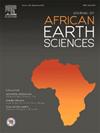The geological and economic legacy of the Pan-african Damara Belt and Lufilian Arc of south-central africa
IF 2.2
4区 地球科学
Q2 GEOSCIENCES, MULTIDISCIPLINARY
引用次数: 0
Abstract
The Neoproterozoic belts of southern Africa, which include the Damara Belt and the Lufilian Arc, have had a significant impact on the understanding of the geology of Southern Africa and related regions. Above all, both belts are economically important as they host metallic and non-metallic mineral deposits of the Kalahari and Central African Copperbelt which are mined in Namibia, Democratic Republic of Congo (DRC), and Zambia respectively. The Damara Belt continues in a north-easterly direction into Botswana, where it continues below the Phanerozoic cover of the Karoo and Kalahari Supergroups to connect in the subsurface with the Lufilian Arc in western Angola and Zambia. The two belts record a full Wilson cycle and form part of a transcontinental suture zone which resulted from the collision between the Archean Congo and Kalahari cratons. The Damara Belt in Namibia, records a progressive increase in metamorphic grade and deformation intensity from sub-greenschist facies on the northern platform to HT/LP granulite facies in the core of the orogen. Similarly, the Lufilian Arc also records a gradual increase in metamorphic grade from sub-greenschist facies in the north (in the DRC) to amphibolite facies in the in the Domes Region in Zambia. Mineralization in these belts differs in style, shape, and size, which can be attributed to the differences in the nature and characteristics of the original sub-basins that formed during rifting, and subsequent deformation. In the Lufilian Arc, ore reserves for individual mines are in the order of 50–810 Mt of ore at 0.5–3 % Cu. This scale is simply not comparable to that in the Damara Belt with tonnages of up to 35 Mt with grades of 0.1–2 % Cu. Both regions also contain numerous smaller copper deposits. On the other hand, the Damara Belt hosts the world class Rossing and Husab uranium mines of Namibia (with grades of 310–450 ppm U) but no major uranium deposits occur in the Lufilian Arc. The Damara uranium deposits occur associated with syn-to post-tectonic granites in the core of the orogen where granite formation was initiated by anatexis of the metasedimentary rocks of the Swakop Group. In contrast, the associated Pb-Zn ± Cu mineralization in both belts appears to be remarkably similar, with comparable deposit sizes, grades, and estimated reserves. The legacy of these two orogenic belts is significant in that the Lufilian Arc serves as the standard or type locality for understanding sediment-hosted Cu-Co deposits globally, whereas the Damara Belt has been the key to understanding granite melt generation by anatexis and formation of granite-hosted uranium deposits in the world.
非洲中南部的泛非达马拉带和卢菲连弧的地质和经济遗产
南部非洲新元古代带,包括达马拉带和卢菲连弧,对南部非洲及相关地区的地质认识产生了重大影响。最重要的是,这两个带在经济上都很重要,因为它们分别在纳米比亚、刚果民主共和国和赞比亚开采卡拉哈里和中非铜带的金属和非金属矿床。达马拉带继续向东北方向进入博茨瓦纳,在那里它继续在Karoo和Kalahari超群的显生宙覆盖下,在地下与安哥拉西部和赞比亚的Lufilian弧相连。这两个带记录了一个完整的威尔逊旋回,构成了太古宙刚果克拉通与卡拉哈里克拉通碰撞形成的横贯大陆缝合带的一部分。纳米比亚达马拉带从北台地的亚绿片岩相到造山带核心的高温/低压麻粒岩相,变质程度和变形强度逐渐增大。同样,卢菲连弧也记录了从北部(刚果民主共和国)的亚绿片岩相到赞比亚Domes地区的角闪岩相的变质品位逐渐增加。这些带的矿化风格、形态和规模各不相同,这与裂陷过程中形成的原始次盆地性质和特征的差异以及随后的变形有关。在陆菲连岛弧,单个矿山的矿石储量为50 - 8.1亿吨,含铜量为0.5 - 3%。这种规模根本无法与达马拉带中吨位高达3500万吨,品位为0.1% - 2%的铜相比。这两个地区还含有许多较小的铜矿床。另一方面,达马拉带拥有纳米比亚世界级的Rossing和Husab铀矿(品位为310-450 ppm U),但在卢菲连弧没有主要的铀矿床。达马拉铀矿床与造山带核心的同-后构造花岗岩伴生,花岗岩是由斯瓦科普群变质沉积岩的深熔作用形成的。相比之下,两个带中相关的Pb-Zn±Cu矿化似乎非常相似,具有相当的矿床规模、品位和估计储量。这两个造山带的遗产意义重大,陆菲连弧是了解全球沉积型铜钴矿床的标准或类型地点,而达马拉带则是了解全球深熔花岗岩熔体生成和花岗岩型铀矿床形成的关键。
本文章由计算机程序翻译,如有差异,请以英文原文为准。
求助全文
约1分钟内获得全文
求助全文
来源期刊

Journal of African Earth Sciences
地学-地球科学综合
CiteScore
4.70
自引率
4.30%
发文量
240
审稿时长
12 months
期刊介绍:
The Journal of African Earth Sciences sees itself as the prime geological journal for all aspects of the Earth Sciences about the African plate. Papers dealing with peripheral areas are welcome if they demonstrate a tight link with Africa.
The Journal publishes high quality, peer-reviewed scientific papers. It is devoted primarily to research papers but short communications relating to new developments of broad interest, reviews and book reviews will also be considered. Papers must have international appeal and should present work of more regional than local significance and dealing with well identified and justified scientific questions. Specialised technical papers, analytical or exploration reports must be avoided. Papers on applied geology should preferably be linked to such core disciplines and must be addressed to a more general geoscientific audience.
 求助内容:
求助内容: 应助结果提醒方式:
应助结果提醒方式:


